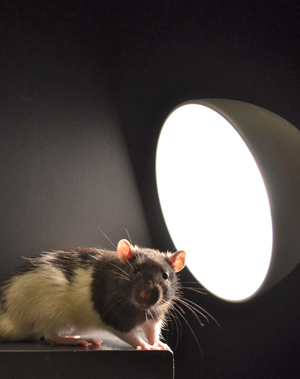UC San Diego Biologists Receive $1 Million W.M. Keck Foundation Grant
July 24, 2013
By Kim McDonald
Biologists at UC San Diego who recently discovered that the brain cells of adult rats can alter the neurotransmitters they secrete in response to changes in the amount of daylight have been awarded a $1-million research grant from the W.M. Keck Foundation. Their mission: to study this neurotransmitter switching mechanism in greater detail so neuroscientists might one day be able to develop new treatments for human brain disorders such as Parkinson’s.

Rats exposed to less light during the day were more likely to explore the open end of an elevated maze, a behavioral test showing they were less anxious.
Davide Dulcis and Pouya Jamshidi, UC San Diego
Since the 1930s, scientists had assumed the type of neurotransmitter secreted by the adult brains of mammals was fixed and invariant throughout life. But Nicholas Spitzer, a professor of biology at UC San Diego, and Davide Dulcis, a research scientist in his laboratory, upended that longstanding belief when they discovered earlier this year that the rat’s brain cells adopt a new chemical code when subjected to large changes in the day and night cycle, flipping a switch to allow an entirely different neurotransmitter to stimulate the same part of the brain.
“Our perceptions, behaviors, emotions, memories and intelligence depend on the appropriate synthesis and release of specific neurotransmitters in the brain,” said Spitzer, director of the Kavli Institute for Brain and Mind, who will lead the three-year study with Dulcis.
Their discovery that the adult mammalian brain is much more malleable than was once thought has opened a new area of inquiry for examining brain disorders, particularly the behavioral changes in our brain linked to light reception, and for new ways to treat disorders such as Parkinson’s, caused by the death of dopamine-generating cells in the brain.
The neurobiologists reported in the April 26 issue of Science that rats exposed for one week to 19 hours of darkness and five hours of light every day had more nerve cells making dopamine, which made them less stressed and anxious when measured using standardized behavioral tests. Meanwhile, rats exposed for a week with the reverse–19 hours of light and five hours of darkness–had more neurons synthesizing the neurotransmitter somatostatin, making them more stressed and anxious.
Humans who live in high latitudes in the Northern Hemisphere during the winter often develop signs of depression and stress–so-called “winter blues” or Seasonal Affective Disorder–caused by low light levels, which can be treated by increasing their exposure to full-spectrum light. Spitzer’s and Dulcis’s discovery provides an explanation for what happens in our brains when this happens and why the situation in rats can be so easily reversed.
“We’re diurnal and rats are nocturnal,” said Dulcis. “So for a rat, it’s the longer days that produce stress, while for us it’s the longer nights that create stress.”
In their study, the scientists plan to collaborate with researchers at the UC San Diego medical school using PET scanning technology to pinpoint the areas in the rat brain where the changes in neurotransmitter activity is occurring. They also hope eventually to enlist the help of engineers and other scientists at the university’s newly established Center for Brain Activity Mapping, in the Kavli Institute for Brain and Mind, to develop tools that can precisely measure the amounts of neurotransmitters being secreted from each neuron over time.
Media Contact: Kim McDonald (858) 534-7572, [email protected]
Comment: Nicholas Spitzer (858) 534-3896, [email protected], Davide Dulcis (858) 534-2456, [email protected]
